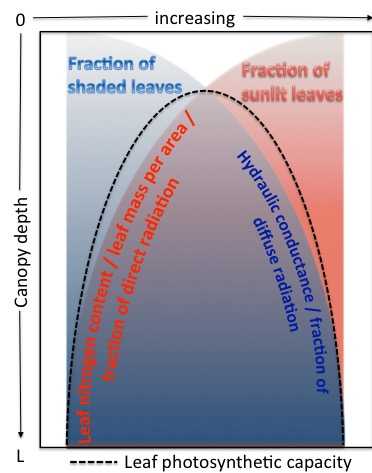Leaf2Canopy
Context
Determining CO2 exchange of forests with a high spatial resolution is important for a more precise understanding of the terrestrial carbon cycle, as well as the impacts of environmental drivers on forest CO2 exchange. While leaf photosynthetic responses to light and other resources are well understood, scaling up from leaf-level photosynthesis to the canopy and landscape CO2 exchange remains a topic of ongoing research.
This project is embedded in the ES1309 COST Action OPTIMISE which explores the use of proximal optical sensing of ecosystems, where carbon and water vapour flux are estimated by eddy covariance techniques.
Objectives
In the project Leaf2Canopy, we investigate vertical gradients of photosynthesis in tree canopies, characterise the underlying leaf traits, and investigate the effect of the microclimate (light, temperature and humidity) on the photosynthesis gradients. The research combines ecophysiological and microclimatical measurements, with the aim of improving forest CO2 exchange- and remote sensing models.
The research is conducted at the Lägeren research site (Lägeren) in a mixed-deciduous forest located on the steep Lägeren mountain at 682 m a.s.l., NW of Zurich.
Hypotheses on within-canopy variations of photosynthesis investigated in this project
We hypothesise that
- Light gradients in forests are determining the distribution of leaf biochemical traits, such as nitrogen and chlorophyll, in the canopy.
- High vapour pressure deficit constrains the photosynthetic carbon uptake in the upper canopy and thus leads to less steep photosynthesis gradients and less than optimal distribution of nitrogen in the forest canopy.
- Coniferous evergreen and deciduous broadleaf trees may respond differently to light and vapour pressure deficit gradients in a mixed forest.

Publications
Bachofen C, Hülsmann L, Revill A, Buchmann N, D'Odorico P (2022) Accounting for foliar gradients in Vcmax and Jmax improves estimates of net CO2 exchange of forests. Agricultural and Forest Meteorology 314: 108771, external page 10.1016/j.agrformet.2021.108771
Bachofen C, D'Odorico P, Buchmann N (2020) Light and VPD gradients drive foliar nitrogen partitioning and photosynthesis in the canopy of European beech and silver fir. Oecologia 192: 323-339, doi: external page 10.1007/s00442-019-04583-x
D’Odorico P, Gonsamo A, Gough CM, Bohrer G, Morison J, Wilkinson M, Hanson PJ, Gianelle D, Fuentes JD, Buchmann N (2015) The match and mismatch between photosynthesis and land surface phenology of deciduous forests. Agricultural and Forest Meteorology 214–215: 25-38, doi: external page 10.1016/j.agrformet.2015.07.005